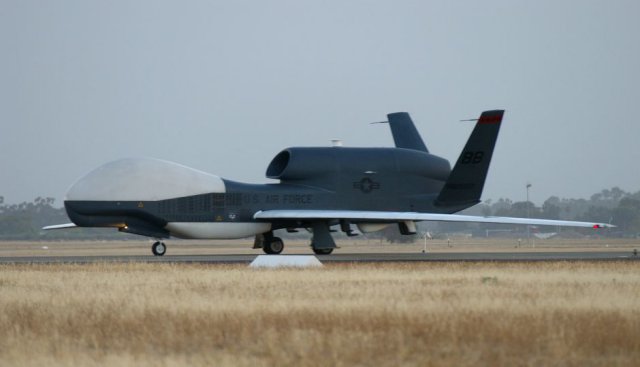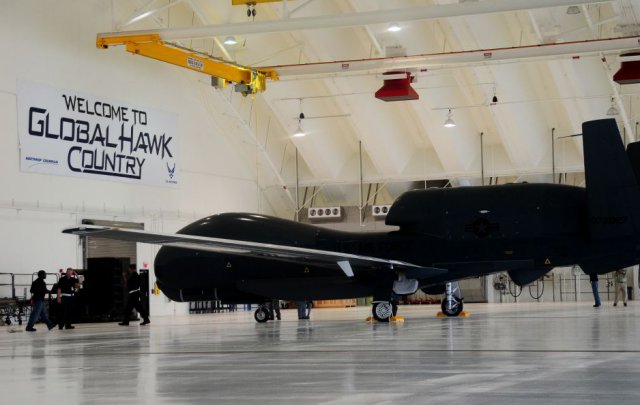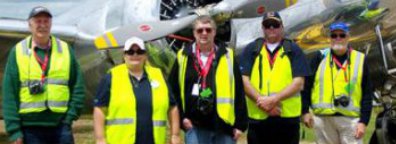 Global Hawk touching down at RAAF Edinburgh in February 2006
Global Hawk touching down at RAAF Edinburgh in February 2006
The United States flew highly classified Global Hawk surveillance missions from the Royal Australian Air Force base at Edinburgh in South Australia from late 2001 until at least 2006.The operations were detected by a group of Adelaide aviation historians who had a member monitoring aircraft radio frequencies 20 hours a day.
With a wingspan greater than a 737 airliner and a $200 million price tag, the RQ-4 Global Hawk is the biggest, most expensive unmanned aircraft to ever take to the skies.
Global Hawk operations are cloaked in secrecy, and the US Air Force likes to keep it that way.
But perhaps the Pentagon severely underestimated the vigilance of Adelaide aviation historians the West Beach Aviation Group (WBAG).
WBAG members have told ABC’s Foreign Correspondent that they monitored the flights until Australian defence security officials paid them a visit and demanded they not publish material revealing the presence of the Global Hawks.
“[The Global Hawks] usually approached and departed at night, although there were a few exceptions – and then they were photographed by the group,” WBAG spokesman Paul Daw said.
“But there were sensitivities. A photographer (from the group) was visited unannounced by Australian military security and questioned for putting movements onto an international web site.
“They claimed he showed vulnerabilities of the base.”
WBAG group members say they take national security seriously, but argue there are no restrictions on photographing or monitoring US aircraft in Australian skies.
Despite the heavy-handed attempt at suppression, details of Global Hawk movements were published in the group’s limited-circulation newsletter.
Still, the US government was determined to keep a lid on the spy drone missions.
Foreign Correspondent understands that in 2004, the then-Australian defence minister, South Australian Liberal senator Robert Hill, notified the Americans of his intention to announce the flights to the Australian public.
But the US Air Force vigorously opposed the defence minister’s planned disclosure, demanding all Global Hawk operations remain classified.
Mr Hill, who has since left federal Parliament, did not respond to requests to comment on this story.
South Australia’s then Labor premier, Mike Rann, who at the time was lobbying for a greater Defence presence in his state, was not told of the sensitive US military flights.
Global Hawk’s only official visit to Australia was in April 2001, touching down at RAAF Edinburgh amid a blaze of publicity as it completed a record-breaking 14,000-kilometre flight across the Pacific from California.
But after the terrorist attacks of September 2001, Global Hawk disappeared off the public radar.
As Washington ramped up its declared war on terror, the unmanned surveillance aircraft were dispatched worldwide. They were seen flying from bases in California and the United Arab Emirates.
But the covert reach of Global Hawk went much further.
Mr Daw says the aircraft began quietly slipping into South Australia two months later, in November 2001.
“The reason we knew a Global Hawk was coming is we’d see a C141 Starlifter arrive up to a week earlier and unload a shipping container or two. These were for command and control – to control the approach of Global Hawk,” he said.
Mr Daw says the group’s 30 volunteers include a retired airline captain, commercial pilots, photographers and an air traffic controller, so they knew exactly what to expect.
He explains that to get a heads-up on approaching aircraft, “one of our guys monitors aircraft radio frequencies 20 hours a day”.
Mr Daw says unusual radio chatter on local air traffic control frequencies heralded the approach of a Global Hawk.
“They used a strange call sign. The Global Hawk would line up to land from 200 nautical miles out over Port Augusta,” he said.
Global Hawk’s American manufacturer, Northrop Grumman, provided civilian ground crews to service the drones at the RAAF base.
Why fly from Australia?
The Australian Defence Department now confirms US Global Hawks visited Australia, but plays down the significance of the missions.
In an email response to our questions a Defence spokesperson said: “Global Hawk visits to Australia are rare but have previously occurred, principally to RAAF Base Edinburgh near Adelaide. Global Hawk visits to Australia since the 2001 trial have been for short replenishment purposes.”
Adelaide was initially a transit stop for Global Hawks en route from the west coast of the US to the Al Dhafra air base in the United Arab Emirates, but a number of aviation industry insiders claim that is not the whole story.
Mr Daw says “the flights were believed to be surveillance missions of Afghanistan”.
Later the UAS stopovers were extended.
“Sometimes a Global Hawk would go out [from RAAF Edinburgh] on two or three flights. The aircraft would climb to 60,000 feet,” Mr Daw said.
“Who knows where they went … they had enough fuel for 30 to 35 hours, and they’d return.”
The aviation enthusiasts say they spotted 10 missions to Adelaide. “But they are just the ones we know about”, concedes one member.
While the Australian public and the South Australian Government were left in the dark, there were no restrictions on the international media.
In February 2006, an American journalist from industry publication Aviation Week and Space Technology was given access to report on a single Global Hawk reconnaissance mission from RAAF Edinburgh to southern Japan and back again.
Officially, this was a demonstration flight for the Japanese, who were keen to acquire Global Hawk.
The timing of the mission was intriguing, launched just one week after North Korea had conducted a series of failed missile tests.
At the time, US intelligence was intensely focused on determining North Korea’s offensive military capabilities.
Were the US Global Hawks targeting countries in our region? And why did the UAS need to fly specifically to Edinburgh for “replenishment”, requiring such a huge detour from the international hotspots they targeted?
The Australian Defence Department refuses to comment.
Mr Daw thinks location was a key factor.
“I believe RAAF Edinburgh was chosen because it is close to but outside a major city, had hangars that could conceal the Global Hawk and back then, it was a quiet base,” he said.
American author Matthew M Aid, an analyst specialising in US intelligence operations in the post-9/11 world, agrees.
He says Global Hawk operations in the Asia-Pacific region have been based out of Andersen Air Force Base on the US territory of Guam – but only since 2010.
He says concealing the presence of the aircraft has always been a priority.
“The problem with Andersen was the lack of hangars. US intelligence doesn’t like the UAS parked out in the open … they’ve got to be in hangars and these weren’t completed until mid to late 2010 to avoid Russian and Chinese satellite detection,” he said.
 Global Hawk inside a hangar at Andersen Air Force Base on Guam – Photo:US Air Force
Global Hawk inside a hangar at Andersen Air Force Base on Guam – Photo:US Air Force
“Almost every day one of the US Air Force Global Hawks based on the island of Guam can be found flying off the North Korean coastline taking pictures of targets deep inside the country that are more detailed than those coming from satellites.
“They fly at 60,000 feet, 75 miles off the North Korean coastline, taking grainy shots taken from a 45-degree angle.”
Mr Aid says that before 2010 “a forward operation location at Edinburgh would have been a perfect place”.
Mr Aid says Global Hawk operations are cloaked in obsessive secrecy. This may explain the heavy-handed response to Adelaide’s West Beach Aviation Group.
“The US Air Force, for some bizarre reason, classifies everything to do with UAS as ‘codeword’ top secret – that means above top secret,” he said.
While Australian military officials were allegedly attempting to suppress disclosure of the flights, it appears Global Hawk’s targets already knew when the aircraft were coming.
“Global Hawk is so big – with sharp angles, with no stealth at all – even a third-rate nation can pick up Global Hawk flights using airport radar,” Mr Aid said.
He says that between 2002 and 2005, Iranian diplomats routinely lodged diplomatic protests over US unmanned surveillance aircraft “flying daily signals intelligence and imagery collection missions along Iran’s borders with Iraq and Afghanistan and along Iran’s Persian Gulf coastline”.
When Global Hawk first visited Australia on its public-relations flight in April 2001, the aircraft was still in its development phase and there were concerns over its reliability, Mr Aid says.
He says after September 11 “the Air Force didn’t really have time to flight-test the Global Hawk, they had to get it operational ASAP”.
“They required hundreds of man hours before every flight – 45 men and women working on each one non-stop to keep it mission capable. The sensors are incredibly complex,” he said.
Mr Aid says maintenance and refuelling stops at Edinburgh made sense on the completion of missions or when the drones were in transit from the US to the Middle East and other locations.
Adelaide was also considered friendly territory.
Mr Aid says the US and Australia share much of the highly sensitive signals intelligence gathered by assets such as Global Hawk.
“Australia is a member of the so-called Five Eyes intelligence club that also includes the US, the United Kingdom, Canada and New Zealand,” he said.
At the time Australia was considering buying Global Hawk, the missions could have given RAAF officers a chance for a closer inspection.
Mr Daw says the Adelaide group last spotted a Global Hawk in 2006. Other aviation industry sources claim the spy drones continued to fly to Australia beyond that date and that RAAF Edinburgh remains on the approved list of landing sites.
Global Hawk sightings have since been limited to a full-size promotional mock-up wheeled out at the Avalon Air Show near Melbourne.
The US Air Force now operates a fleet of 23 Global Hawks from a headquarters at Beale Air Base in California and a facility at Grand Forks, North Dakota.
The aircraft maintain global surveillance coverage by rotating through three forward operating bases: Al Dhafra in the UAE, Sigonella US Naval Air Station on Sicily and Andersen Air Force Base on Guam.
If the US military was seeking plausible deniability, then perhaps the Global Hawks should have stayed well away from Adelaide and the city’s vigilant aviation enthusiasts.
Photos: WBAG
Source: ABC News


This is old news mascarading as new news because of lack of knowledge within the Australian media. The story was first reported in Flight International by myself in 2006. Seehttp://www.flightglobal.com/news/articles/australia-brings-hale-uav-project-forward-by-a-year-205343/
Australia brings HALE UAV project forward by a year
By: London
12:00 7 Mar 2006
Scheduling shift comes as Asia-Pacific nations consider plans for Global Hawk ‘pool’
The Australian government is to consider proposals in the next three months for initial funding of its Project Air 7000 Phase 1 high-altitude, long-endurance (HALE) multi-mission maritime unmanned air vehicle requirement. The initial funding approval has been brought forward by at least a year from previously declared plans for the project.
Australia last month hosted a Pacific Air Force demonstration of a prototype Northrop Grumman RQ-4A Global Hawk deployment over east Asia, with loiter time over Japan and Singapore. The UAV involved – air vehicle 3 – was the same RQ-4A that has been operating from the Al Adeid air base in Qatar since late 2001 and racked up 4,800 combat flight hours in support of US operations in Afghanistan, Iraq and the horn of Africa.
The UAV left Qatar on 10 February and arrived at the Royal Australian Air Force’s Edinburgh base north of Adelaide the following day. The east Asian demonstration occurred between 13-18 February before the air vehicle returned to Edwards AFB, California on 20 February.
RAAF Edinburgh supports one of only two US Air Force-funded RQ-4 support centres outside the USA. It has hosted at least 10 Global Hawk transits between the USA and Qatar since 2001, including deployment of two USAF RQ-4A production UAVs, the first of which passed through Australia on 12 January.